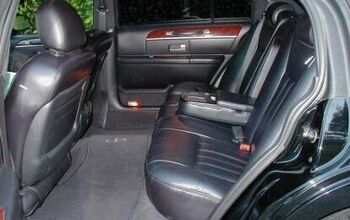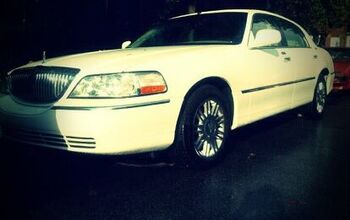Panther Appreciation Week: Defining Panther Love
As someone who has driven over 300,000 non-livery, private-owner miles in various iterations of Ford’s Panther, TTAC’s Panther Appreciation Week struck a bittersweet chord for me. I’ve enjoyed seeing this versatile vehicle-from-another-era get the admiration and respect I believe it deserves, and the peek at the other side of the philosophical coin – courtesy of some Best & Brightest commentators (and Paul) – has also been interesting. But this tribute to the platform’s imminent demise has saddened me, as it highlights how the Panther has represented such a stoic constant on North American roads for so many years. Regardless, change is the only true constant, and it won’t be long before the pride of St. Thomas Assembly is irretrievably crushed by the ever-advancing juggernaut of modernity. Standing at the precipice of this retirement, I feel compelled to look at what the Panther has meant, both in my life, and in the market over these past three decades.
First off, full disclosure: At nine years old, I learned to drive in an ’81 Country Squire wagon, so it goes without saying that the big cat’s claws are forever embedded in my heart. From there, Panther proximity became less a sentimental thing and more an association of convenience: with a top Ford-Lincoln-Mercury salesman for a father, these cars were just always around. This made possible multiple Panther memories, including:
* Counting down the New Year in 1987 with eight members of my extended family in an ’85 Colony Park wagon after being rear-ended in traffic at 11:45 p.m.
* Reaching for an ’86 Crown Vic rear door handle after my first involuntary police car ride (for driving without a license) and realizing it wasn’t there
* Getting my first speeding ticket (83 in a 35) at 16 in a brown ’84 Grand Marquis
* Driving an old lady’s ‘85 Crown Vic like a maniac to an emergency animal hospital (to no avail)
* Arriving at my senior prom in a dark green ’89 Town Car that exactly matched my suit
* Buying my first non-Thunderbird – a white ’92 Crown Vic – and velcroing a big blue coffee cup to the dash so I’d look like a cop (much fun ensued)
* Being so impressed with the ’92 that I bought a ’95 Crown Vic
* Being so impressed with the ’95 that I purchased an ’01 Grand Marquis
* Riding in one of several hundred P71 Police Interceptors in my killed-in-the-line-of-duty cousin’s police funeral
* Watching my ’01 Grand Marquis hit 200,000 miles last week, knowing that it’s not unreasonable to expect 100,000 more
Throughout all of this, I had a ring-side seat to how Panthers performed in the market, courtesy of my dad’s occupation. From the “more luxurious/expensive/profitable-by-the-pound” successful early years, to the emergence of the “old person’s car” connotation, to the de-contented fleet stripper it ultimately became, watching this compromised-but-never-compromising, confounding-but-always-confident icon of mid-century American auto design outlast its market segment was as comforting as Rush Limbaugh is to a Republican.
It should be said, though, that some part of the Panther’s longevity stems from functional nostalgia – my current car seats six, pulls a trailer, swallows massive amounts of cargo, and regularly returns and honest-to-goodness 20 miles per gallon in mixed city/suburban/highway driving. Don’t even mention the ease of maintenance and lowest-on-earth cost/availability of replacement parts. Utility-wise, I’d put a used Marquis up against a comparably-pre-owned CUV any day of the week, and the Mercury would win on value every time (and cost several Grand less doing it).
Of course, the Panther platform has its (many) (glaring) faults, and if you point these out, I certainly won’t argue. I know the rear seat should be roomier and that the rear doors should open wider. I’m aware that making the car handle like a “modern automobile” is difficult and quickly becomes a nightmare of diminishing returns. And yes, to be a big, old-fashioned luxo-barge, it should ride better. Nevertheless, those that assail the Panther based on such observations miss the object of their objectivism: Supposing that the standards of automotive preference are truly standardized is just as fallacious as the fan-boy fanaticism that fuels these critics’ ire.
What I mean is that the things people love about their cars – and cars in general – is paradoxically different, and the same. To wit: the track-day superstar gives the same loving glance back at his Lotus after a day of hot-lapping as the gentle octogenarian does to his ’54 Oldsmobile after an evening reminiscing at the drive-in.
I think guys like Jay Leno have the right attitude. They celebrate automotive enthusiasm in multiple contexts, allowing for the fact that what is good in one context may not be in another. And no, that’s not relativism – good and bad both still exist in such a paradigm, more attention is just paid to what’s an apple and what’s an orange. Probably, the Panther would get a fairer shake from such a perspective than by being compared to current mass-market offerings like the Camry or the LaCrosse.
When automotive history looks back to situate the Panther, I hope it will be judged as a good car for its time, and one that kept delivering value – both to its manufacturer and to its owner – long after that time ended. But I know it will be remembered as one thing if nothing else: a survivor.
More by Don Gammill Jr.
Latest Car Reviews
Read moreLatest Product Reviews
Read moreRecent Comments
- Peter I want a self driving red ragtop 1958 Plymouth Fury. Just like the car in the movie Christine.
- Mgh57 Doesn't seem like this tech is ready for prime time.
- Nathan The Ram is the most boring looking of the full size trucks, kind of like a Tundra.If they cancel the Ram Classic, I hope a full resign makes the Ram at least look interesting.
- DJB1 I'll be all for it when it has a proven safety record. I have an awesome life and a lot to live for, so right now I'm not putting that in the hands of overconfident tech-bros.
- Mgh57 I had to read the article because I had had no idea what the headline meant. I've never seen this in the Northeast. Don't understand the point. Doesn't seen efficient aerodynamically


































Comments
Join the conversation
For a cool commercial (VW) that features the pretty taillights of a MGM in the closing seconds, see: http://wheels.blogs.nytimes.com/2010/09/25/classic-ad-volkswagen-jetta/
Mercury should have kept making/developing the Marauder. I have the 2009 Fleet Ultimate which I have upgraded into a fine handling car. I have a video of the car upgraded. It now does 0-60 in 6.8 seconds and 1/4 in 15.5, and handles as well as it stops with upgraded brake pads. http://www.youtube.com/watch?v=D6Z-wk042sE